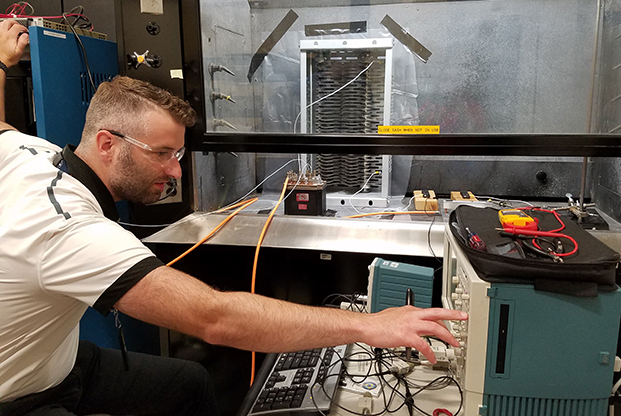
Air Force Research Laboratory electrical engineer Corey Boltz makes final adjustments before conducting a proof-of-concept arc test in preparation for follow-up testing to support a NASA research effort. Air Force photo by Holly Jordan.
The gig economy is headed for the Air Force Research Laboratory.
Lab officials want to revamp their workforce to better reflect a modern economy marked by the proliferation of side hustles and odd jobs, as well as one that can rapidly evolve alongside technological advancements.
To prepare for the workforce of 2030, AFRL studied other organizations’ best practices from fall 2017 through the end of 2018. The laboratory found it needs to embrace a gig-economy model, offer short-term projects as well as longer jobs, and allow employees to work remotely.
Other findings addressed the prospect of losing experienced science, technology, engineering, and math personnel, as well as the need to protect sensitive information during collaborative efforts, Jessica Salyers, AFRL’s deputy executive director, told Air Force Magazine in a series of recent emails.
The deep dive comes as the Air Force tries to be a better bureaucracy by pushing prototypes, stressing innovation, and pivoting to emerging technologies like hypersonic weapons, artificial intelligence, and advanced networking. The service’s research arm wants to ensure it’s in a good position to handle the ripple effects of those changes.
AFRL will address its largest problems—like updating the recruiting, hiring, and interviewing process—in phases.
“Once we are able to tidy up these basic stepping stones of [the] workforce, then we look forward to future phases of experimentation where we can bring in some novel and exciting ideas related to gig projects, etc. to fruition in AFRL,” Salyers said.
AFRL conducted more than 100 interviews on workforce trends with representatives from Pentagon labs, civilian government agencies, universities, and “household-name companies,” according to Salyers.
“It was somewhat surprising to find that many organizations, like us, were stuck in a reactive model of simply backfilling positions as they became vacant, rather than having the ability to forecast out future technology needs, then tie those to the talent needed to accomplish our mission in those areas [via new hires, and via offering ongoing technical development for our current workforce],” she said.
Over the next year and a half, AFRL will edit its hiring procedures to try to find better candidates sooner. Bringing a new employee on normally takes more than 180 days to process paperwork and complete other tasks, Salyers said. Even the fast-track “direct hire” process typically takes 80 days or longer. Lab officials want to cut their best-case hiring scenario from 42 days to 10 days.
Now, AFRL will let applicants meet hiring managers and potential coworkers in formal and informal settings during the interview process to see how well the team would work together.
“We hope that by expanding our recruiting and interviewing processes, among others, we can get a wider more diverse candidate pool in the door,” Salyers said. “We can gather more data points about an employee before we decide to interview or hire, whereas today we only have a resume and 30-minute interview to go on.”
Officials hope the changes will make AFRL positions more attractive to top talent when compared to higher-paying jobs outside of government.
More than 10,000 employees currently work at AFRL, which manages a $4.8 billion research and development portfolio of internal and external projects. Salyers acknowledged making changes to an institution of that size will be difficult.
“We are excited to lead the way in changing how we do business not only from a technology perspective, but from a process perspective,” Salyers said. “We know that in order to compete globally for top tier talent, we will need to change. The question is, how will we need to change, and which of those changes do we have the authority to impact today?”
The team crafting Air Force Secretary Heather Wilson’s “Science and Technology 2030” outlook are incorporating the workforce study’s findings into its own report, she added. Those forthcoming recommendations will point to the technology areas where AFRL needs to direct its talent.
